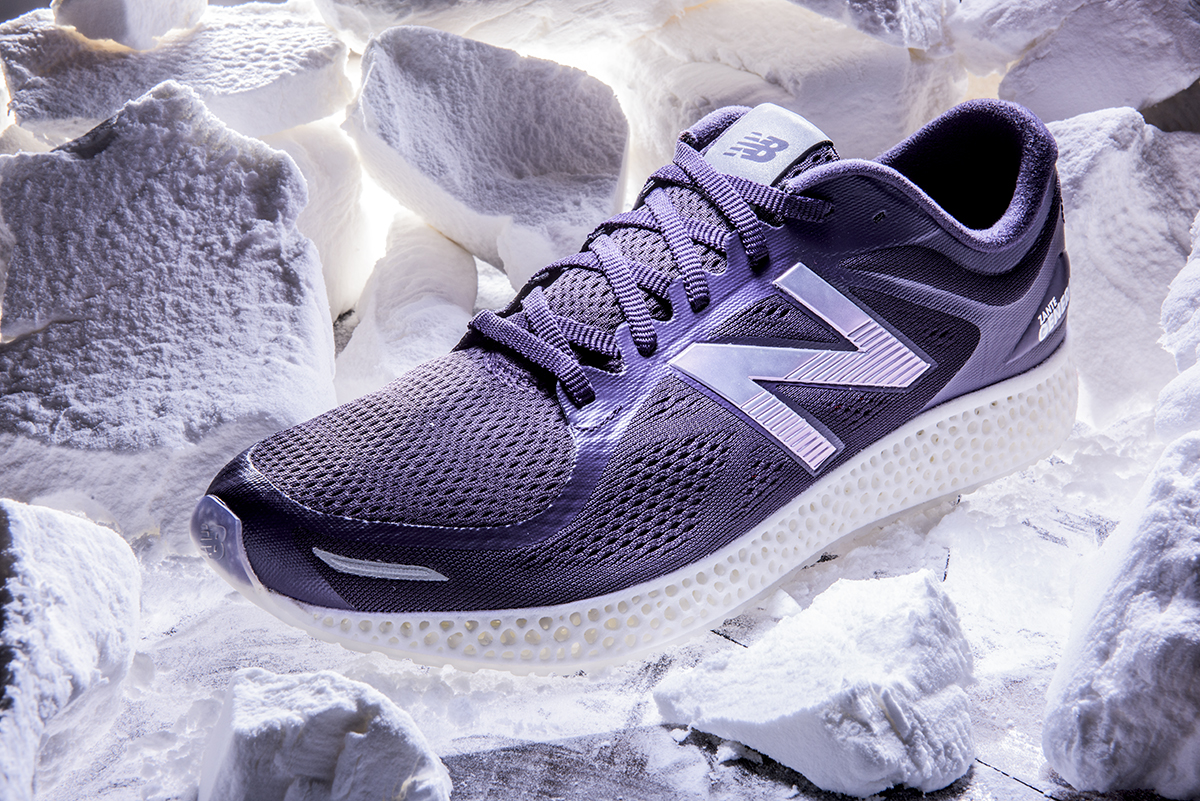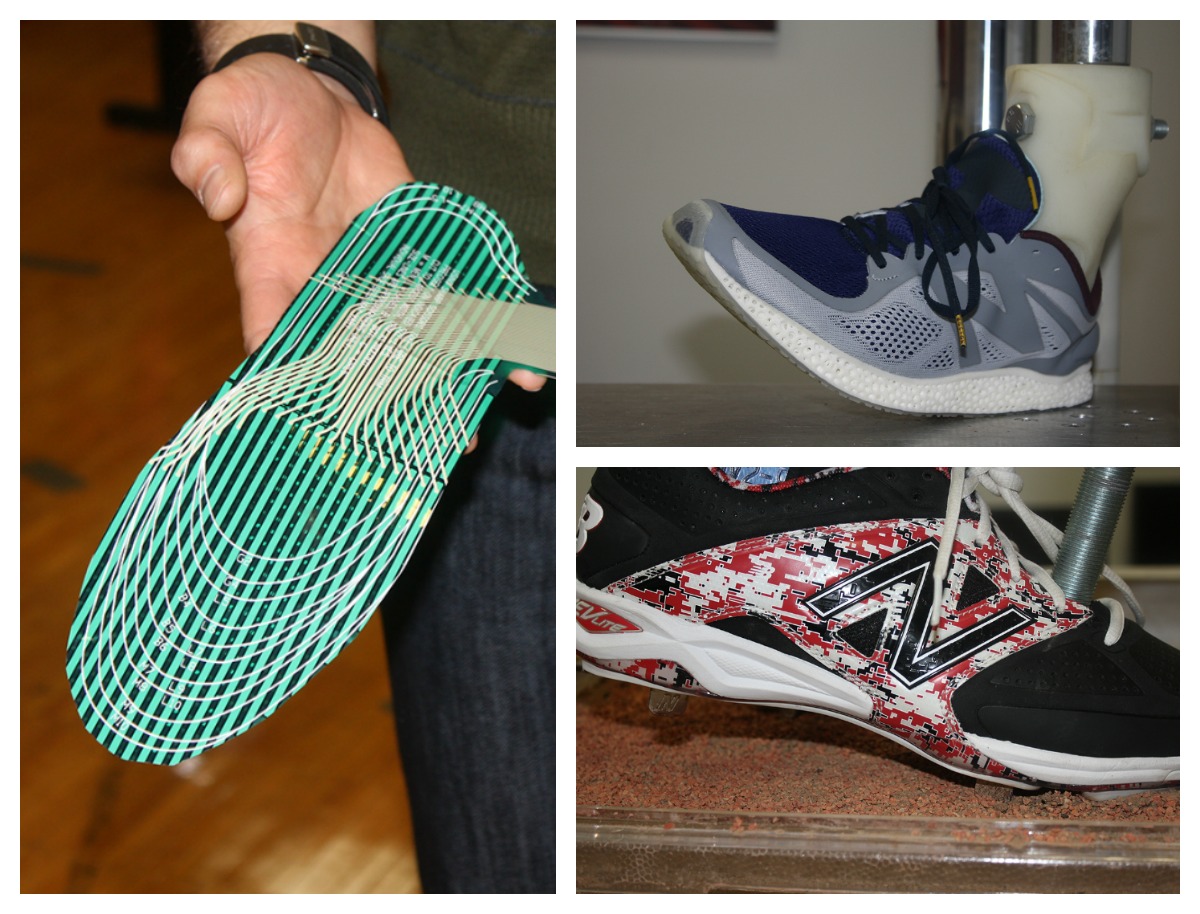An Inside Look at New Balance, 3D-Printed Shoes, and the Future of Fast

New Balance’s Lawrence facility. / Photo by Jamie Ducharme
In a nondescript mill building opposite the Lawrence Commuter Rail station, New Balance is trying to change the way you move.
The Lawrence facility may be less ornate than New Balance’s shiny new Brighton headquarters, but it quietly houses a factory that churns out between 2,500 and 3,000 pairs of shoes per day; a Sports Research Lab that puts new products through rigorous testing; multiple rooms devoted to 3D printing; and an Innovation Studio dedicated to shaping the future of performance footwear. This is where, as New Balance says, the company is trying to mold the future of fast.
These days, they’re focusing heavily on 3D printing. On April 15, the company will begin selling—for the bargain price of $400—the Zante Generate, the industry’s first performance running shoe with a 3D-printed midsole.

The Zante Generate, in manufacturing in Lawrence. / Photo Provided
For now, the first production run—each stage of which happens under the Lawrence factory’s roof—is limited to 44 pairs, one for each year since Chairman Jim Davis purchased the company in 1972. Those 44 pairs have been years in the making. Three, to be exact.
New Balance designers began experimenting with 3D-printed running shoes years ago, but struggled to create a product that was functional and comfortable enough for serious use. Many of the old prototypes, still on hand in Lawrence, feel as brittle as uncooked pasta.

The progression of New Balance’s 3D-printed shoes. / Photo by Jamie Ducharme
The current model, the one that will go to market, is made using selective laser sintering (SLS), a process through which layer after layer of powder is painstakingly turned to a solid, with the help of a powerful laser. At the end of the SLS process, the sole is encased in a cake of powder so thick, it needs to be excavated out with tools that wouldn’t look out of place on an archeological dig.
Right now, the shoes’ quality is about on-par with conventionally made performance running shoes. Katherine Petrecca, New Balance’s general manager for studio innovation, says it can only go up from here.
“We will ultimately be able to deliver better performance features with this process,” she says. “For consumers, this is really an opportunity, as we want to move into individual performance customization, individual cosmetic customization.”

The Zante, on the powder its sole is made from. / Photo Provided
New Balance will only deem the shoes superior, however, after they go through a long, rigorous trial period. Cutting-edge shoes, including the Zante Generate, go through a barrage of tests at the Lawrence facility, as evidenced by the rainbow of sneakers that litter the building’s every surface, waiting to be smashed and stretched and studied until they’re declared acceptable.
In-house, there’s flexibility testing, force testing, durability testing, motion capture testing, traction testing, fit testing, and more. One machine can, in a single day, replicate the wear and tear of running 500 miles; another uses dirt from a certain famous ballpark to measure cleats’ traction.
Sometimes, says Sports Research Lab Head Trampas TenBroek, the team even tests competitors’ shoes to inspire improvements in its own products. “What do we definitely want to make sure we do better?” he says. “It’s always fun to cut them in half and see what’s there.”
Beyond the facility’s walls, prototypes are sent to some of New Balance’s 150,000 consumer testers, who wear the sneakers for a set period of time, provide feedback, and send them back to the lab, usually dusty and dirty. Only rarely, says TenBroek, are photos leaked to social media—and the insights gleaned from human testers make that risk palatable.
“You can do lab testing, you can do finite element analysis of a design, but until you actually make something and get it under people’s feet, you don’t really understand how it’s going to perform,” Petrecca says.

Shoes undergo testing in the ‘Smash Lab.’ / Photos by Jamie Ducharme
Finalizing the Zante Generate was even more arduous than usual, Petrecca says, because the design process was largely foreign. New Balance designers are accustomed to working in 2D, an obvious limitation when trying to make a 3D-printed product. Beyond that, the company had to wait for 3D-printing technology to catch up to its lofty design ambitions.
“One of the reasons that we wanted to put shoes into the market was to help push everybody forward,” Petrecca says, “and move this out of the lab and into the public view.”
As of press time, days before the Zante Generate is due to hit the market, Petrecca says New Balance is already at work on a new venture, this one still top-secret.
“It’s gone from somewhat of a high-concept project for us, three years ago, to something that we now very seriously consider,” she says.
After all, moving things forward is the New Balance way.
The Zante Generate will go on sale for $400 at 9 a.m. on April 15 online and at New Balance’s 583 Boylston Street store. For more information, visit newbalance.com.

